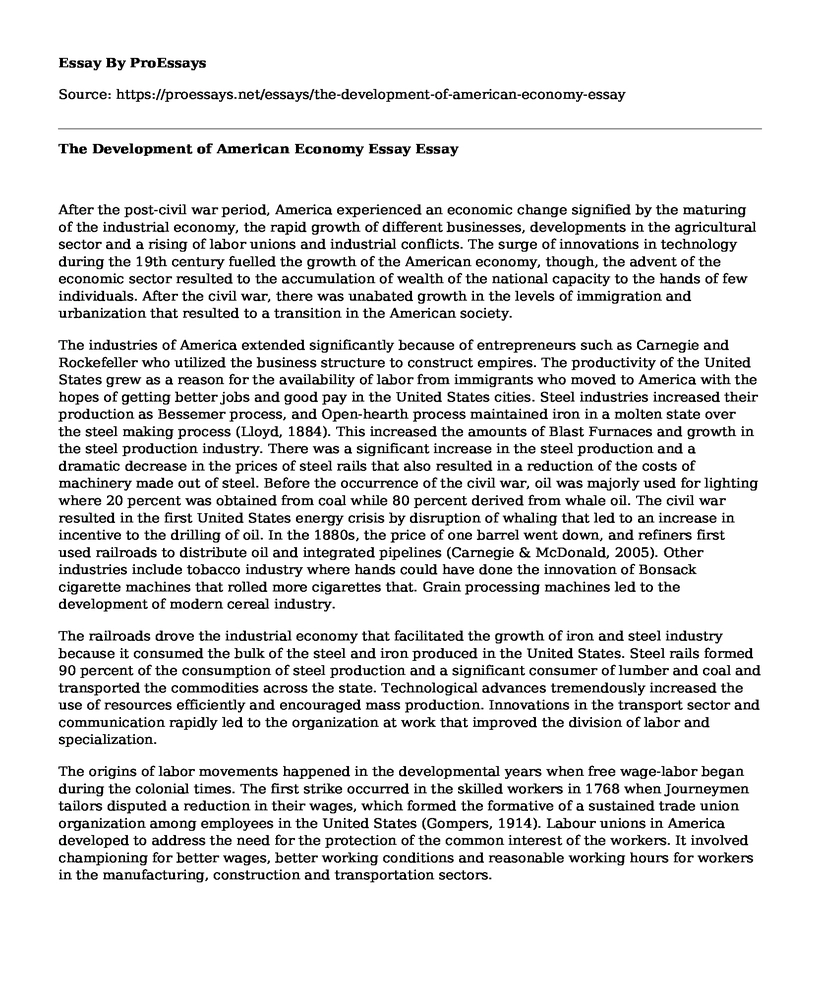After the post-civil war period, America experienced an economic change signified by the maturing of the industrial economy, the rapid growth of different businesses, developments in the agricultural sector and a rising of labor unions and industrial conflicts. The surge of innovations in technology during the 19th century fuelled the growth of the American economy, though, the advent of the economic sector resulted to the accumulation of wealth of the national capacity to the hands of few individuals. After the civil war, there was unabated growth in the levels of immigration and urbanization that resulted to a transition in the American society.
The industries of America extended significantly because of entrepreneurs such as Carnegie and Rockefeller who utilized the business structure to construct empires. The productivity of the United States grew as a reason for the availability of labor from immigrants who moved to America with the hopes of getting better jobs and good pay in the United States cities. Steel industries increased their production as Bessemer process, and Open-hearth process maintained iron in a molten state over the steel making process (Lloyd, 1884). This increased the amounts of Blast Furnaces and growth in the steel production industry. There was a significant increase in the steel production and a dramatic decrease in the prices of steel rails that also resulted in a reduction of the costs of machinery made out of steel. Before the occurrence of the civil war, oil was majorly used for lighting where 20 percent was obtained from coal while 80 percent derived from whale oil. The civil war resulted in the first United States energy crisis by disruption of whaling that led to an increase in incentive to the drilling of oil. In the 1880s, the price of one barrel went down, and refiners first used railroads to distribute oil and integrated pipelines (Carnegie & McDonald, 2005). Other industries include tobacco industry where hands could have done the innovation of Bonsack cigarette machines that rolled more cigarettes that. Grain processing machines led to the development of modern cereal industry.
The railroads drove the industrial economy that facilitated the growth of iron and steel industry because it consumed the bulk of the steel and iron produced in the United States. Steel rails formed 90 percent of the consumption of steel production and a significant consumer of lumber and coal and transported the commodities across the state. Technological advances tremendously increased the use of resources efficiently and encouraged mass production. Innovations in the transport sector and communication rapidly led to the organization at work that improved the division of labor and specialization.
The origins of labor movements happened in the developmental years when free wage-labor began during the colonial times. The first strike occurred in the skilled workers in 1768 when Journeymen tailors disputed a reduction in their wages, which formed the formative of a sustained trade union organization among employees in the United States (Gompers, 1914). Labour unions in America developed to address the need for the protection of the common interest of the workers. It involved championing for better wages, better working conditions and reasonable working hours for workers in the manufacturing, construction and transportation sectors.
Conclusion
The labor union formed the Congress for Industrial Organizations that recognized the potential command of organizing employees across occupational lines that led a more solid Union and established its core consistency. The passage of the Social Security Act ensured improvements in the public health and championed for the provision of a pension to workers and preserve social security. The National Labour Relations Act forms the basis of the contemporary labor law in the United States that give unions the right to bring together and compel workers to bargain jointly regarding employment terms and conditions.
References
Carnegie, A., & McDonald, A. L. (2005). The gospel of wealth: Two Essays. McLean, VA: Trinity Forum.
Gompers, S. (1914). The American labor movement: Its makeup, achievements, and aspirations. Washington, D.C.: The American Federation of Labor.
Lloyd, H. (June 1884). "The Lords of Industry," North American Review 331. Journal of Political Economy, 19(5), 434-434. doi: 10.1086/251867
U.S. Senate: Classic Senate Speeches. (2018). Retrieved from http://www.senate.gov/artandhistory/history/common/generic/Speeches_ClayAmericanSystem.html
Cite this page
The Development of American Economy Essay. (2022, Jul 03). Retrieved from https://proessays.net/essays/the-development-of-american-economy-essay
If you are the original author of this essay and no longer wish to have it published on the ProEssays website, please click below to request its removal:
- Essay Example on Performance-Based Budgeting
- John Paul Getty Biography
- The Decline in the Dollar Value Paper Example
- Essay Sample on The Growth of African Kingdoms
- Essay on US War on Terror: Targeted Killings, Mass Surveillance, & Detention
- Essay Example on The Industrial Revolution: Transforming US Economy and Society
- Annie Oakley: West America - Movie Review Sample







